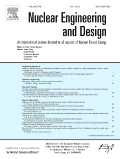
NUCLEAR ENGINEERING AND DESIGN
Scope & Guideline
Advancing Nuclear Innovation for a Safer Tomorrow
Introduction
Aims and Scopes
- Nuclear Reactor Design and Safety:
Research on the design principles and safety characteristics of various reactor types, including pressurized water reactors (PWR), boiling water reactors (BWR), and advanced concepts like small modular reactors (SMRs) and molten salt reactors. - Thermal-Hydraulics and Fluid Dynamics:
Studies focusing on the thermal-hydraulic behavior of reactor systems, including flow dynamics, heat transfer phenomena, and the impact of coolant characteristics on reactor performance. - Neutronics and Fuel Cycle Analysis:
Investigations into neutron behavior, fuel utilization, and cycle management, including studies on fuel performance, burnup analysis, and optimization of fuel loading patterns. - Severe Accident Analysis and Mitigation:
Research dedicated to understanding and mitigating the consequences of severe accidents in nuclear facilities, including modeling and simulation of accident scenarios and the performance of safety systems. - Advanced Materials and Corrosion Studies:
Exploration of new materials for reactor components, including corrosion resistance and mechanical performance under operational conditions, as well as innovative fuel designs. - Computational Methods and Simulation Techniques:
Development and application of advanced computational methods, including computational fluid dynamics (CFD), Monte Carlo simulations, and machine learning techniques for enhancing reactor design and safety assessments.
Trending and Emerging
- Small Modular Reactors (SMRs):
There is a growing emphasis on the design, safety, and operational aspects of small modular reactors, which are viewed as key to future nuclear energy strategies due to their flexibility and scalability. - Accident-Tolerant Fuels (ATFs):
Research into accident-tolerant fuels has gained momentum as the industry seeks to enhance the safety and performance of nuclear fuel under severe accident conditions. - Machine Learning and AI Applications:
The integration of machine learning and artificial intelligence into nuclear engineering is trending, particularly for predictive modeling, anomaly detection, and optimization of reactor operations. - Sustainability and Environmental Impact Studies:
There is an increased focus on the sustainability of nuclear energy through studies on waste management, recycling of actinides, and the long-term impacts of nuclear technologies on the environment. - Digital Twins and Real-time Monitoring:
The application of digital twin technology for real-time monitoring and predictive maintenance of nuclear facilities is emerging as a vital area of research, enhancing operational safety and efficiency.
Declining or Waning
- Traditional Reactor Types:
There has been a noticeable decrease in research specifically focused on traditional reactor types such as older PWR and BWR designs, as the field shifts towards newer technologies such as SMRs and advanced reactors. - Subcritical Reactors:
Research on subcritical reactors has diminished in recent years, possibly due to the increasing focus on fast reactors and molten salt reactors which are seen as more viable for future energy needs. - Conventional Fuel Cycles:
Interest in conventional uranium fuel cycles has waned as researchers increasingly turn towards alternative fuels, including thorium and advanced fuels that promise improved sustainability and safety. - Basic Thermal-Hydraulic Studies:
While thermal-hydraulic studies remain important, the focus has shifted from basic principles to more complex scenarios involving advanced reactor designs and safety systems, resulting in fewer publications on fundamental thermal-hydraulic concepts.
Similar Journals
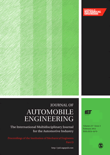
PROCEEDINGS OF THE INSTITUTION OF MECHANICAL ENGINEERS PART D-JOURNAL OF AUTOMOBILE ENGINEERING
Elevating Standards in Mechanical and Aerospace EngineeringPROCEEDINGS OF THE INSTITUTION OF MECHANICAL ENGINEERS PART D-JOURNAL OF AUTOMOBILE ENGINEERING, published by SAGE PUBLICATIONS LTD, is a premier peer-reviewed journal dedicated to advancing the field of automobile engineering. Established in 1989, this journal serves as a vital platform for researchers, professionals, and students interested in the latest advancements in automotive technology and engineering practices. With a significant focus on aerodynamics, vehicle dynamics, and safety innovations, it consistently ranks in the Q2 quartile within both Aerospace Engineering and Mechanical Engineering, showcasing its influence and reliability in the academic community. The journal is indexed in Scopus with impressive rankings, being placed in the 41st percentile for Aerospace Engineering and the 214th percentile for Mechanical Engineering, further solidifying its importance in these fields. As an important resource for cutting-edge research, the journal does not currently offer open access, making it a great venue for disseminating substantial findings that drive the future of automotive innovation.
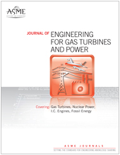
JOURNAL OF ENGINEERING FOR GAS TURBINES AND POWER-TRANSACTIONS OF THE ASME
Pioneering Research in Energy and Aerospace EngineeringJournal of Engineering for Gas Turbines and Power - Transactions of the ASME, published by the esteemed American Society of Mechanical Engineers (ASME), is a leading interdisciplinary journal dedicated to advancing the fields of energy engineering, aerospace, nuclear energy, and mechanical engineering. With an impressive history dating back to 1960 and continuing its contributions through 2024, this journal boasts a Q2 ranking in multiple engineering categories, reflecting its strong impact on both academia and industry. Although not an open-access journal, it provides invaluable insights and research findings that cater to the needs of professionals, researchers, and students alike. The journal's ISSN is 0742-4795 with an E-ISSN of 1528-8919, ensuring widespread visibility in the global academic community. Indexed in Scopus, it ranks notably within its fields—21st in Nuclear Energy and Engineering and 51st in Aerospace Engineering—underscoring its relevance and contribution to critical technological advancements. Researchers in this domain will find the journal a vital resource for innovative studies, practical applications, and the latest developments related to gas turbines and power generation.

ATW-INTERNATIONAL JOURNAL FOR NUCLEAR POWER
Catalyzing Progress in Nuclear Power TechnologyATW - International Journal for Nuclear Power is a premier journal dedicated to advancing the understanding and application of nuclear technology within the energy sector. Published by INFORUM Verlags-Verwaltungsgesellschaft mbH, this esteemed publication provides a platform for researchers, professionals, and students to disseminate cutting-edge research, practical applications, and critical analyses related to nuclear power generation. Although it has discontinued coverage in Scopus since 2012, its long-standing contributions to the field since 1996 underscore its significance and relevance. The journal aims to bridge the gap between theoretical insights and real-world applications, ensuring that stakeholders are well-informed on the latest trends, safety protocols, and innovations in nuclear power. With a commitment to fostering knowledge dissemination and collaboration, ATW continues to be an essential resource for anyone involved in the nuclear energy landscape.
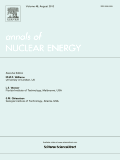
ANNALS OF NUCLEAR ENERGY
Exploring the Depths of Nuclear Engineering ExcellenceANNALS OF NUCLEAR ENERGY, published by Pergamon-Elsevier Science Ltd, is a premier interdisciplinary journal in the field of nuclear energy and engineering. Holding an impressive Q1 ranking in its category as per the 2023 evaluations, it is recognized for its significant contributions to the advancement of nuclear science and technology. With its extensive publication history since 1975 and a convergence period extending to 2025, the journal aims to disseminate high-quality research, innovative methodologies, and critical reviews that address the challenges and developments in nuclear energy systems. Though the journal does not offer open access options, it remains a vital resource for researchers, professionals, and students seeking to stay abreast of the latest trends and breakthroughs in this essential field. Its commitment to fostering academic discourse ensures that contributors and readers alike are engaged in shaping the future of energy solutions.

SAE International Journal of Passenger Vehicle Systems
Transforming Ideas into Automotive SolutionsWelcome to the SAE International Journal of Passenger Vehicle Systems, a premier publication in the realm of automotive engineering. Published by SAE International, this journal serves as a critical platform for disseminating high-caliber research focused on the innovation and advancement of passenger vehicle systems. With an impact factor that reflects its growing influence, this open-access journal enhances visibility and accessibility, supporting a diverse readership that includes researchers, engineers, and automotive professionals. Covering a broad scope that incorporates safety, reliability, and mechanical engineering among others, the journal is categorized in the Q3 and Q4 quartiles for various engineering fields, indicating its significance and the potential for impactful contributions to ongoing discussions within the automotive sector. The Scopus rankings further underscore its commitment to quality, placing it within the mid-range of prominent publications. As a valued resource, the SAE International Journal of Passenger Vehicle Systems from 2022 to 2024 offers a vital forum for knowledge exchange, aimed at inspiring breakthroughs in automotive technology and enhancing passenger safety.

Problems of Atomic Science and Technology
Unveiling the Future of Nuclear Engineering.Problems of Atomic Science and Technology is a leading journal in the realm of nuclear physics and technology, published by the esteemed Kharkov Institute of Physics and Technology. With an ISSN of 1562-6016, this journal is dedicated to disseminating high-quality research and advancements in atomic sciences, contributing significantly to both academic and practical applications in the field. Although not an open access publication, it ensures rigorous peer review standards to maintain the integrity and relevance of cited works. The journal seeks to provide a vital platform for researchers, professionals, and students who are engaged in the exploration of atomic phenomena, nuclear engineering, and associated technologies. Published from Kharkov, Ukraine, the journal also serves as a bridge for international collaboration and innovation, making it indispensable for anyone looking to stay at the forefront of atomic science research.
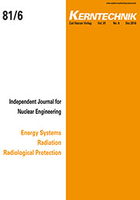
KERNTECHNIK
Innovating nuclear technologies through rigorous research.KERNTECHNIK is a distinguished journal specializing in the fields of Materials Science, Nuclear and High Energy Physics, and Nuclear Energy and Engineering. Published by WALTER DE GRUYTER GMBH, this journal has continuously contributed to advancing knowledge and research in nuclear technologies and related safety measures since its inception in 1969. With an ISSN of 0932-3902 and an E-ISSN of 2195-8580, KERNTECHNIK serves as a vital platform for academics and professionals seeking to delve into both theoretical and practical aspects of nuclear science and technology. Though listed in the Q4 quartile across multiple categories in 2023, the journal's commitment to publishing rigorously peer-reviewed articles ensures that it remains a respected resource, facilitating academic discourse and innovation. It is particularly aligned for those conducting research or working in safety, risk, reliability, and quality within the nuclear sector, and its extensive historical archive allows for in-depth exploration of evolving technologies. Aimed at foster cooperation between researchers, policymakers, and industry experts globally, KERNTECHNIK continues to play an important role in shaping the future of nuclear science.
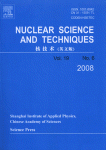
Nuclear Science and Techniques
Illuminating Innovations in Nuclear ScienceNuclear Science and Techniques is a distinguished peer-reviewed journal published by Springer Singapore Pte Ltd, dedicated to advancing the fields of nuclear science and engineering. With an impressive impact factor reflected in its 2023 quartile rankings—Q2 in Nuclear and High Energy Physics and Q1 in Nuclear Energy and Engineering—the journal serves as a vital resource for researchers, professionals, and students alike. Covering a breadth of topics from nuclear physics to energy applications, it offers a platform for innovative research and developments in the nuclear domain. The journal, indexed under ISSN 1001-8042 and E-ISSN 2210-3147, aims to foster scientific exchange and collaboration within the community by publishing high-quality articles that contribute significantly to the field. Committed to maintaining an open-access ethos, it enhances visibility and accessibility of critical knowledge, making it an essential source for current insights and trends in nuclear science.
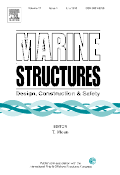
MARINE STRUCTURES
Advancing Knowledge in Ocean EngineeringMARINE STRUCTURES, published by Elsevier Science Ltd, is a premier scholarly journal that has established itself as an essential platform for the dissemination of cutting-edge research in the fields of Marine Engineering, Ocean Engineering, and Materials Science. With an impressive H-index reflecting its substantial citation impact, and boasting a Q1 ranking across several categories including Materials Science and Mechanical Engineering as of 2023, this journal is recognized globally for its contributions to advancing knowledge and innovation in marine structures. The journal covers a wide range of topics, from the design and analysis of marine structures to the latest technologies and methodologies in ocean engineering, making it invaluable for researchers, professionals, and students alike. As the journal continues to publish high-quality articles that explore contemporary challenges and opportunities within the marine domain, it serves as a catalyst for collaboration and knowledge exchange among academia and industry. Researchers are encouraged to submit their original works and benefit from the rigorous peer-review process that ensures the quality and reliability of published content. MARINE STRUCTURES is not currently an open access journal, providing a subscription-based model that facilitates access to its authoritative body of knowledge.
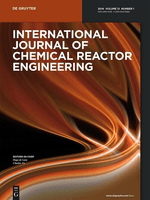
International Journal of Chemical Reactor Engineering
Enhancing Knowledge in Chemical Reactor Design and SafetyInternational Journal of Chemical Reactor Engineering, published by WALTER DE GRUYTER GMBH, serves as a vital platform for advancing knowledge in the field of chemical engineering, specifically focusing on reactor engineering. The journal, recognized by its ISSN 2194-5748 and E-ISSN 1542-6580, has maintained its commitment to quality research since its inception in 2002 and spans converged years through 2024. With a respectable Q3 ranking in the miscellaneous category of Chemical Engineering and a current Scopus rank of 158/273, it represents a significant resource for researchers aiming to publish innovative findings and practical applications. Although it operates under a subscription model, it still attracts attention for its rigorous standards and insightful contributions to the field. The journal’s focus on the interdisciplinary aspects of chemical reactor design, optimization, and safety underscores its importance in driving forward the technical and theoretical boundaries of chemical engineering. Addressed from Genthiner Strasse 13, D-10785 Berlin, Germany, the International Journal of Chemical Reactor Engineering is a must-read for professionals and scholars dedicated to pushing the frontiers of chemical reaction technologies.